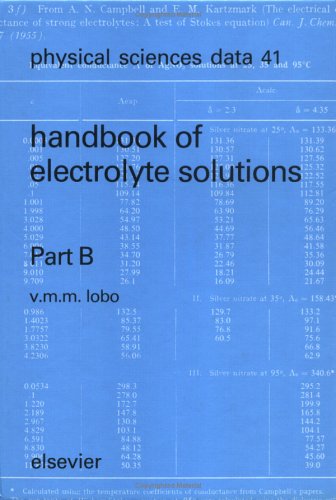Physical Sciences Data
2 total works
This compilation - the first of its kind - fills a real gap in the field of electrolyte data. Virtually all self-diffusion data in electrolyte solutions as reported in the literature have been examined and the book contains over 400 tables covering diffusion in binary and ternary aqueous solutions, in mixed solvents, and of non-electrolytes in various solvents. An important feature of the compilation is that all data have been critically examined and their accuracy assessed. Other features are an introductory chapter in which the methods of measurement are reviewed; appendices containing tables of the limiting self-diffusion coefficients of ions; and a list of references to data which have been omitted but where information about the diffusing system is given. This is the only complete compilation of self-diffusion data in electrolyte solutions. It will appeal to electrochemists in general, particularly now that recent developments in the theory of transport processes require these data. It will also have a special appeal to electroanalytical chemists in that the ionic self-diffusion coefficient is an important quantity for the interpretation of electrode reactions.
The development of science and technology demands precise data concerning the fundamental thermodynamic and transport properties of ionic solutions. Many fields, such as corrosion, pollution, food technology, biochemical phenomena, rates of reactions, etc., which involve such solutions, have been moving towards a more scientific treatment. Accordingly, the relevant fundamental parameters need to be known over a wider scale.
Whereas some recent fields of science have information concentrated in a few specialist journals covering only a short span of time, the basic thermodynamic and transport properties of aqueous solutions are scattered among hundreds of different journals over a period of many decades. To aid the specialist in the search for one of these properties, the author has compiled comprehensive data from the literature on
1. Density. 2. Viscosity. 3. Conductance. 4. Transport numbers. 5. Diffusion coefficients. 6. Activity coefficients (and osmotic coefficients)
of aqueous solutions of binary inorganic electrolytes, listed in alphabetical order according to the chemical formula.
A list of electrolytes by alphabetical order of name in English is given in appendix I. All properties of a single solute are grouped together, thus forming a chapter, divided in sections according to temperature, e.g. Section 0 has data of the above six properties measured at 0°C, below 0°C or up to 2.4°C. Section 5, 10, 15, 20, 25, 30, 35, 40, 45 have data measured at the indicated t temperature or within the range t - 2.5°C
The present work is of immense value to those interested in readily assessing all the data of a single solute at a certain temperature, and appropriate indices easily supply the information of a certain property in every electrolyte.
Whereas some recent fields of science have information concentrated in a few specialist journals covering only a short span of time, the basic thermodynamic and transport properties of aqueous solutions are scattered among hundreds of different journals over a period of many decades. To aid the specialist in the search for one of these properties, the author has compiled comprehensive data from the literature on
1. Density. 2. Viscosity. 3. Conductance. 4. Transport numbers. 5. Diffusion coefficients. 6. Activity coefficients (and osmotic coefficients)
of aqueous solutions of binary inorganic electrolytes, listed in alphabetical order according to the chemical formula.
A list of electrolytes by alphabetical order of name in English is given in appendix I. All properties of a single solute are grouped together, thus forming a chapter, divided in sections according to temperature, e.g. Section 0 has data of the above six properties measured at 0°C, below 0°C or up to 2.4°C. Section 5, 10, 15, 20, 25, 30, 35, 40, 45 have data measured at the indicated t temperature or within the range t - 2.5°C
The present work is of immense value to those interested in readily assessing all the data of a single solute at a certain temperature, and appropriate indices easily supply the information of a certain property in every electrolyte.

